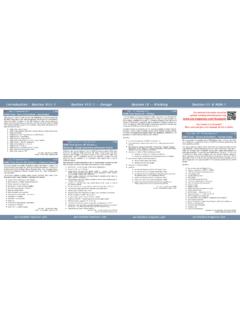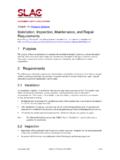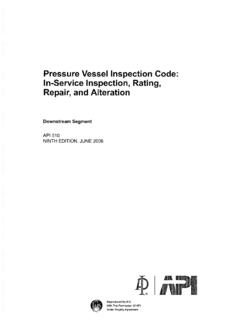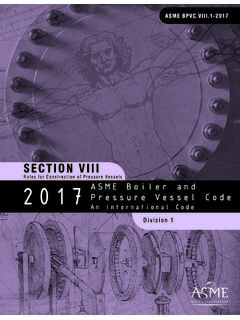Transcription of ASME Code and PED - The new Section VIII Division 2 ...
1 Presentation at 8th European pressure Equipment Conference 25-26 June 2009, F rstenfeldbruck, Germany Page 1 ASME Code and PED - The new Section VIII Division 2 - really everything new? Dr. Dirk K lbl, Essen 1. SummaryASME has published a completely rewritten Section VIII Division 2. Under the PED this Division evidences advantages compared to the preceding editions. Numerous changes have been compiled to a modern pres-sure vessel Code, which has the potential for an international best-seller. Compliance with PED is not guaran-teed, but made easier than in the past. Now it is up to the users to vote for the success of the new Division 2.
2 Code and PEDASME Boiler and pressure vessel Code, published by the American Society of Mechanical Engineers, is frequently used to fulfil the European pressure Equipment Directive (PED). Not much in Germany, however in the south of the EU, and even more in the Middle East and overseas ASME Code is the most frequently used Code for pressure equip-ment. Manufacturers, Contractors, Engineering companies and Owners of pressure equipment like to specify ASME Code, and often use this well known Code also under the PED. Comparison of ASME and PED, although pub-lished in many occasions, are not really appropri-ate. The PED is a regulation at the location of in-stallation, and enforced by laws in the entire EU.
3 ASME Code on the other hand is a technical standard in this context. It is not enforced by law in the EU, and used for the technical details of the design and fabrication of pressure equipment. To comply with the PED, Guideline 9/6 can be used as a help for the manufacturer to prepare his design package and to perform the hazard analysis as required by the PED. All Essential Safety Re-quirements published in Annex 1 of the PED shall be met. Annex 1 Chapter 1 through 6 are compulsory while chapter 7 requirements, if not met, may be re-placed by evidence that appropriate measures have been taken to achieve an equivalent overall level of safe-ty.
4 The evaluation shall be documented by the manufacturer in the design package, which will be submitted to the Notified Body for approval in cas-es where the chosen conformity assessment mod-ule specifies this. All Codes, specifications, and standards, when used should be used entirely. Cherry picking is certainly not recommended. Section VIIIS ection VIII comprises of three Divisions. Division 1 is the most commonly used Code for pressure Vessels all over the world. Division 2, written for Engineered pressure Vessels shows a much more sophisticated design approach. It contains methods for stress analysis, fatigue and creep analysis, combined with a sophisticated scope of non-destructive examination and amplified re-quirements on fabrication and material control.
5 The more complex design approach requires certifica-tion by an experienced Professional Engineer (RPE). The specific efforts to meet all the addition-al requirements is compensated by a higher utilisa-tion of material strength to carry stresses. The use of Section VIII Division 2 is suitable in cases where the saved material could compensate the additional efforts, or when the purchaser of the vessel specifies Division 2. Section VIII Division 3 was first published in 1997. It specifically addresses pressure vessels designed for high pressures exceeding 70 MPa. new Section VIII Division 2On July 1st, 2007 the 2007 Edition of the ASME Code was published, including Section VIII Div.
6 2, which was completely re-written. A new book. For all pressure vessels contracted for after Jan 1st, 2008 the new rules are mandatory, except when Code Case 2575 is specified. This case extends the transition period until June 30th, 2009. The new Division 2 was developed in a completely new structure: PART 1 - GENERAL REQUIREMENTS PART 2 - RESPONSIBILITIES AND DUTIES PART 3 - MATERIALS REQUIREMENTS PART 4 - DESIGN BY RULE REQUIREMENTS PART 5 - DESIGN BY ANALYSIS REQUIREMENTS PART 6 - FABRICATION REQUIREMENTS PART 7 - INSPECTION AND EXAMINATION REQUIREMENTS PART 8 - pressure TESTING REQUIREMENTS Presentation at 8th European pressure Equipment Conference 25-26 June 2009, F rstenfeldbruck, Germany Page 2 PART 9 - pressure vessel OVERPRESSURE PROTECTION Nine parts are addressing the key aspects of pres-sure vessel construction.
7 Additional requirements are specified in Normative Annexes to the parts. Guidance and information is attached in Informa-tive Annexes. Not only the structure is new, also the technical contents and numerous details have been changed significantly. The result is a real new Code for pressure vessels. Many of the changes are an-swering demands arising from international users. The Design Specification and the Design Report for example may be certified by an RPE or by an-other competent, and experienced person ac-ceptable to the authorities at the location of instal-lation. A change that was requested by the industry for many years.
8 The design approach was revised completely. Now Design by Formula is not more mandatory when Design by Analysis is performed. In the design rules, the use of computers has been considered, the method for stress analysis and even the criteria for establishing allowable design stress values were changed. Even more changes were planned and may be expected in the upcoming Editions and Addenda. The non-destructive examination was revised to re-flect examination groups and allowing spot-examination, all quite similar to EN 13445. Even material toughness requirements and the hydro-static test pressure were changed to the values specified in the PED.
9 Consequently some, but not all discrepancies to the PED in technical details were eliminated, which will make it easier to fulfil PED with a Divi-sion 2 vessel . Some requirements of the PED are still not met by Division 2. The required Hazard Analysis, Particular Material Appraisals for ASME material, material certification ( ), approval of Welding procedures and personnel qualification by the Notified Body are still unanswered by Division 2, just to mention the major topics. 5. Experience The past ten years have proven that ASME Code may well be used by contractors and manufactur-ers to demonstrate compliance to the PED.
10 Difficulties have been detected in many areas, and further problems will be to show in the future. The most critical areas are: - Mixing of Codes (where interfaces are defined improperly, or conflicts are not considered) - Incompetent manufacturers, contractors, engi-neers, inspectors - Material certification - Differences in safety culture - Incomplete or inadequate specifications for pressure equipment The new Section VIII Division 2 will not solve all of these problems, but it will be easier to use in the PED environment than preceding editions. The first year of experience with the new Division 2 has shown some manufacturers joyfully working in the new environment, some carefully stepping ahead with proven design under the new rules, and some anxiously awaiting the next specification, and afraid to open the new book.









